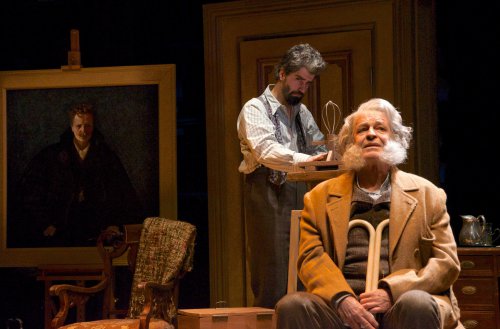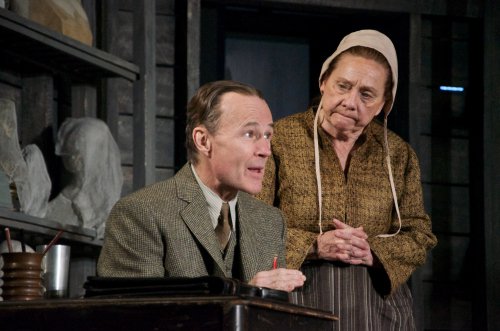Posterity
Two giants in the 19th century Norwegian art firmament lock horns with tragic results.
In Doug Wright’s Posterity at the Atlantic Theater Company, two monumental cultural figures of 19th century Norway lock horns in a battle of wits and sensibilities with tragic results. Wright, who seems to have a penchant for writing about real people (viz. Quills, I Am My Own Wife, and Grey Gardens), here, takes on Henrik Ibsen, monumental 19th century playwright, and sculptor Gustav Vigeland, forty years his junior.
As Posterity opens, it is 1901, Kristiana (now Oslo) Norway. Gustav Vigeland’s young, handsome apprentice Anfinn (Mickey Theis) and old Greta (Dale Soules), housekeeper to Sophus Larpent, are posing for a statue, naked. (A photo of the actual sculpture appears in the program notes.) This shocks the puritanical Larpent (Henry Stram), Vigeland’s patron, as he excitedly bursts into the studio. With great difficulty, he has arranged for Vigeland (Hamish Linklater) to sculpt a bust of Ibsen (John Noble). Larpent thinks is a great honor. Vigeland disagrees.
The grey-toned studio, filled to the ceiling with covered busts, is put into order to welcome Ibsen, who has made many exacting conditions. Refreshments are arranged. Then the discord begins.
Ibsen, iconic mutton chops and all, storms in ogre-like, his jacket bearing honorific ribbons, barking at Anfinn, Greta and Larpent. The sculptor, who takes his time to make his entrance, and the playwright start off on the wrong foot. Their mutual distrust begins with not so subtle sardonic comments about each other’s art forms and goes downhill from there. Their long, coolly observed repartee reveals not only their individual philosophies of art and culture, but their personal prejudices. Their parrying heats up and Ibsen becomes visible ill.
Act Two leads to a more intimate relationship. Ibsen, a pale shadow of his robust self, now poses at his home and the two artists develop a wary peace. Vigeland is hampered by a lack of modeling clay because his assistant, Anfinn, neglected to prepare it for this important posing session. Vigeland has to vamp while Larpent searches all over the town for clay. Anfinn runs away in shame. His terrible fate is recounted at the very end of the play.
Wright’s writing, although often ponderous, is informed by the characters’ idiosyncrasies. From the idle gossipy chatter of Greta and Anfinn to the high falutin’ parrying of Ibsen and Vigeland, the lines are carefully crafted to bring these people to life. Posterity can be a bit slow going, but it’s always worthwhile.
Mr. Wright directs this production and inspires fine acting from the entire cast. Theis makes Anfinn’s devotion palpable. Soules, totally unabashed in her nudity, finds all of Greta’s earthy colors. Stram is all jitters and correctness as Larpent. Linklater’s Vigeland is a portrait of a not-so-young, not-so-old artist still working on his big break (which he gets). He manages to let his boyish looks inform the mature man. Australian stage star John Noble is particularly impressive. A large man, Noble fills the stage with his personality. His Ibsen is an impressive creation.
Derek McLane’s sets were effective in showing the difference between the two artist’s milieus. Susan Hilferty’s costumes were period perfect.
Posterity (through April 5, 2015)
Atlantic Theater Company at the Linda Gross Theater, 336 West 20th Street, in Manhattan
For tickets call 866-811-4111 or visit to http://www.AtlanticTheater.org
Running time: two hours and 15 minutes including one intermission








Leave a comment